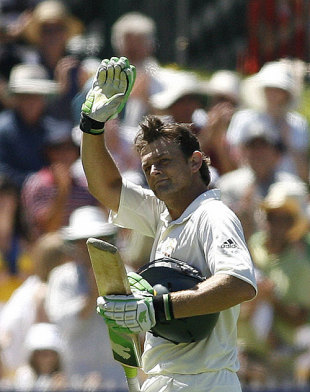|
|
|

Lucky seven: many other teams would have pushed Gilchrist up the order once he began scoring big
© AFP
|
|
| |
To the victor, the spoils. And to the retiring member of a victorious team, even more spoils. Adam Gilchrist has been praised to the skies, like Glenn McGrath and Shane Warne a year ago - perhaps more so, with his ability to combine genius with dignity. And he deserves all the applause, but one of the factors behind his success has been underplayed. He wasn't just an outstanding player; he was used in an outstanding way.
In Tests, he nearly always batted at number seven. At first, this was just standard stuff. Most teams stick the keeper at seven, and Australian teams nearly always do, with their rock-solid habit of playing six specialist batsmen and four bowlers. (If Andrew Symonds keeps on growing into a true Test allrounder, he will be their first one since Richie Benaud.) Australia's masterstroke with Gilchrist wasn't starting him at seven, but keeping him there.
Many other teams would have pushed him up the order once he began to get big scores, which he did straightaway - 81 off 88 balls in his first Test, a matchwinning 149 not out off 163 in his second, both against Pakistan. (With Gilchrist, even more than other modern players, you have to log the balls.) But if Steve Waugh felt any temptation to promote Gilchrist, he largely resisted it. He gave him a single go at number four in a third-innings thrash against India at the MCG in 1999-2000 (he made 55 off 73), and one at three in a far more tense third innings, in the final Test of the epic 2001 series, when Gilchrist fell lbw to Harbhajan Singh for the third time in four and added another 1 to a bizarre sequence of 122, 0, 0 and 1.
There was also one outing at six against England at The Oval in 2001, when Gilchrist joined Waugh himself in the middle with Australia 489 for 3 (Justin Langer had retired hurt). But Gilchrist was just as likely to go down the order as up: Waugh used a nightwatchman more often than you might think, which gave Gilchrist the chance to put his feet up for even longer, before sauntering out as the world's scariest number eight.
| |
|
|
|
| |
| The only man to have scored more Test runs in the bottom five is Kapil, who made 4828 in 163 innings outside the top six. Gilchrist managed almost as many - 4429 - in 51 fewer innings |
| |
Later, he had a couple of brief stints at number six, but not because Waugh or Ricky Ponting wanted him any higher: it was just to make room for a fifth bowler, on the rare occasions when the Aussies decided they needed a second spinner. Gilchrist ended up batting 100 times at number seven, and 12 times at eight, out of 137 innings in 96 Tests (more often than not, he didn't need to bat twice in a match). He was simply the best number seven in history. He made more runs there than anyone else, and dwarfed any of his rivals' strike rate - his was 83, well ahead of other six-hitting sevens. Kapil Dev came close with 78, in a more sedate era; but Andrew Flintoff (68), Lance Klusener (65), Chris Cairns (63) and Ian Botham (62) were all way behind.
Gilchrist's presence and power meant that, while many opponents had it in them to reduce Australia to, say, 230 for 5, few could bowl them out for less than 400. Waugh had hit on a simple truth: that the fall of the fifth wicket is often a fork in the road of a game. One more wicket, and the fielding side are down to the tail; one decent stand, and they are knackered; one blast from Gilchrist, and they are a rabble.
The only man to have scored more Test runs in the bottom five is Kapil, who made 4828 in 163 innings outside the top six. Gilchrist managed almost as many - 4429 - in 51 fewer innings. He averaged 46 in the bottom five, to Kapil's 31. Gilchrist's tally of 13 Test hundreds in the bottom half of the order is the same as the next two players - Kapil and Botham - put together. As the seventh batsman in a mighty line-up, Gilchrist often had to wait exceptionally long for his turn. But when he got in, he was explosive. He was like a perfect pay-off line: all the better for being delayed.
Tim de Lisle is the author of Young Wisden. His website is www.timdelisle.com
